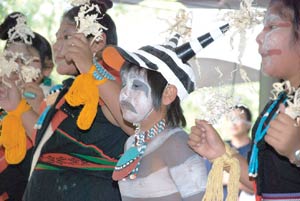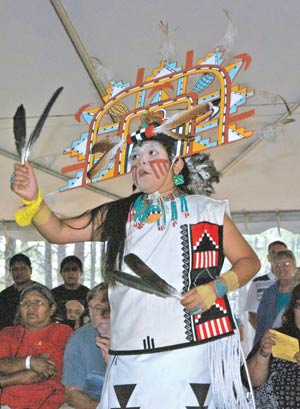Festival celebrates Hopi way of life
By Krista Allen
Western Agency Bureau
FLAGSTAFF, July 11, 2013


(Times photo – Krista Allen)
TOP: The Nuvatukya'ovi Sinom Dance Group performed the Koshari Clown Dance over the weekend during the 80th annual Hopi Festival of Arts and Culture at the Museum of Northern Arizona in Flagstaff.
SECOND FROM TOP: The Nuvatukya'ovi Sinom Dance Group performed the Palhik Mana Butterfly Maiden Dance over the weekend during the 80th annual Hopi Festival of Arts and Culture at the Museum of Northern Arizona in Flagstaff. The Palhik Mana is also known as "Water Drinking Girl."
E velyn Numkena says it takes about five minutes to make one sheet of piki, which is cooked on a hot stone until dry.
"Then you do another one," said the young Shongopavi Village native from Second Mesa, Ariz. as she dipped her fingers in the batter of blue cornmeal and reed bush ash. She rubbed it onto the highly heated, hard sedimentary rock that has been passed down through generations.
Numkena then overlaid the baking piki with the previous sheet to soften. Finally, the two transparent sheets were loosely rolled into piki bread about 10 inches long and two inches in diameter.
Piki bread is a traditional staple of the Kiis'áanii that is typically made on a slab of limestone secured in a dwelling called a piki house.
"They're just small buildings," said one of Numkena's family members. "They have a chimney going out."
However, Evelyn Numkena cooked her piki breads on a modern propane burner over the weekend at the 80th annual Hopi Festival of Arts and Culture.
The festival marked eight decades at the Museum of Northern Arizona (MNA) in the pines where Donald Dawahongnewa and his niece, Tiffany Bahnimptewa, started Saturday morning by singing several of their traditional songs about the traditions of corn as it relates to the Hopi way of life.
The festival continued with a Koshari Clown Dance performed by the Nuvatukya'ovi (which means the San Francisco Peaks) Sinom Dance Group that performed other dances throughout the day.
"(The Koshari) is a Tewa clown with black and white stripes," said Edward Honyestewa, an artist from Second Mesa who sold his alabaster sculptures. "They try to show people how we are so we can fix it and change for the better."
In fact, Tewa clown performances provide social control by demonstrating how not to behave. According to Hopi culture, Tewa clowns are tradition keepers and teach lessons about the good and bad in man.
Honyestewa's wife, Iva, sold baskets that she made from yucca.
"I started weaving 16 years ago," said Iva as she showed her decorative baskets. "I do different items. I try to find new ideas every year."
And so far, she has made cradleboards, sandals, and a three-dimensional basket with a turtle in the center.
In the creative corner of the festivities, children made take-home crafts including dolls made out of dried cornhusks.
"At the museum, we are very excited to reach the 80-year mark for the Hopi festival, originally known as the Hopi Craftsman Exhibition.
The festival is "a place where culture, creativity, and community happen," said museum director Robert Breunig in a press release.
More than 53 Hopi artists gathered at this year's festival. Among those artists included Ramson Lomatewama, a prolific artist who works in many types of media especially glass work.
The MNA has a long and illustrious history and evokes the very spirit of the Colorado Plateau, serving as the gateway to understanding the region with nine exhibit galleries revealing native cultures, artistic traditions, and natural sciences.
Contact Krista Allen at kallen@navajotimes.com

